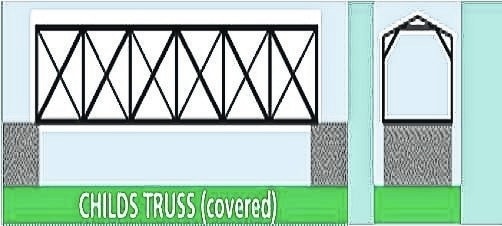
GRATIS TOWNSHIP — Let’s take a little time to discuss the bridge design of the next six covered bridges, which I like to refer to as the “white-painted” covered bridges. These bridges, the Brubaker, Dixon’s Branch, Harshman, Geeting, Christman and Warnke covered bridges, feature the Childs truss design and were built by Evret S. Sherman.
Developed in 1846 by Horace Childs, the Childs truss was used exclusively after 1883 by bridge builder Everett Sherman. The reason for this is the fact that the bridge design was patented and the builder had to pay a royalty to the inventor for the use of his design. The truss simply added diagonal iron rods to a multiple kingpost design.
Now, to make you a bridge aficionado to impress your children, grand-children or the out of town guest, looking at the illustration above, the long horizontal line on the top is called the Top Chord. The long horizontal line on the bottom chord is the Bottom Chord. Easy enough, right? The vertical lines are the Verticals and the diagonal lines are called Diagonals.
To become an expert, you must understand the concept of tension and compression. Tension simply means forces are trying to pull something apart and compression means forces are trying to push something together. So on a Childs truss, the top chords are always in compression, the bottom chords are always in tension, the verticals are in compression and the diagonals are in tension. Now you’re an expert. Hoorah!
For extra credit, when looking at an iron bridge the rods are always in tension because what would happen if you tried to compress a rod? Exactly, it would bow and not carry any load.
The Brubaker covered bridge is the oldest of the “white-painted” covered bridges in the county, featuring the Childs truss design. The Brubaker is located in Gratis Township and, fittingly enough, is located on Brubaker Road, across Sam’s Run. The 88 feet long bridge was built in 1887 by E.S. Sherman at a cost of $986 and the abutments built by T. J. Smith for $1,422. Wow, I sure wish we could build bridges today for what it cost in 1887.
More extra credit — why are the sides open on the Brubaker? Originally, the sides were completely covered on the Brubaker like all the other covered bridges. Since the bridge is located with sharp curves on both ends, it became necessary to open the sides so approaching traffic could be seen before entering the bridge. With the removal of the sides, on-lookers can easily view the natural scenic setting of the hills and valley in the area.
In 2001, the Preble County Engineers Department began preliminary work on the Brubaker Covered Bridge Renovation project. This project was initially approved for the National Historic Covered Bridge Preservation Program using 80% of federal funds. Because of the war in Iraq, the federal funds were not allocated for this previously approved project. Due to the persuasive efforts of Linda Bailiff of the Office of Local Assistance, the Ohio Dept. of Transportation agreed to fund this project using state money and we received $237,600 in state funding and used $92,400 of PCEO money to complete this project. The load limit was also increased from a 5-ton to a 12-ton load limit bridge. The project was completed in 2006.
In closing, I’m reminded of a story concerning my cousin’s wife. Although my cousin was born and raised near Dayton, Ohio, he and his family moved to southern California after his graduation from high school. He married a girl from southern California who had never been very far from home. Sadly, they returned to Ohio for the burial of my aunt, his mother. Mike shared stories of growing up in Ohio with his wife and one of the fascinating stories to her was about Mike’s trip to the covered bridges in his youth. She had never seen wooden covered bridges, just the concrete interstate bridges. After the funeral, which was in late Fall, Mike asked me to take his family to see one of the covered bridges and I chose the Brubaker. I was explaining to the adults the uniqueness of the structure and the craftsmanship of the bridge, while the children were playing in Sam’s Run. I left Mike and his wife alone on the bridge while I went to look at something. Upon my return, I heard Mike laughing. When I got closer, he said to me, “Steve, you have to hear this. My wife was wondering if we had had a forest fire in the area like we have in southern California.”
He could see the puzzled look on my face and continued.
“She noticed all the trees in the area of the bridge didn’t have any leaves on them and wondered if we had a forest fire,” he then explained to her that in the Midwest, with the change of seasons, trees naturally lose their leaves in the fall.
I guess we sometimes take it for granted that everyone knows about what we would call “natural occurrences.” I think this could also apply to our unique covered bridges.


